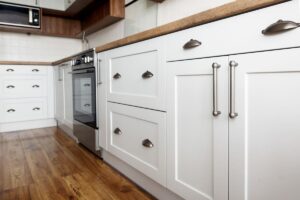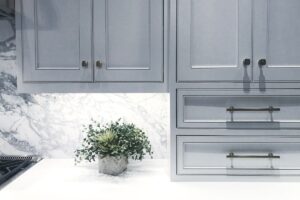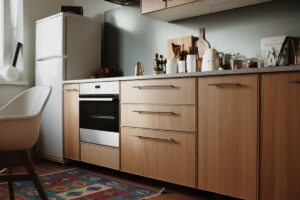Selecting between Waypoint Cabinets vs Kraftmaid is no trivial matter; both brands offer distinct advantages that could be the solution to your cabinetry woes.
Often, homeowners find themselves caught in a dilemma of compromising either on quality or budget when selecting cabinets.
The main aim of this blog article is to dispel your uncertainties by comparing these two prominent brands meticulously.
By the end of this read, you’ll have a transparent understanding of the key differentiators like material quality, durability, and cost to make an informed decision.
Quick Comparison Between Waypoint and Kraftmaid
| Criteria | Waypoint Cabinets | Kraftmaid Cabinets |
|---|---|---|
| Materials | Maple, Oak, Walnut, Cherry, Duraform | Hickory, Alder, Evercore |
| Quality | Average, Upper Builder Grade | Better, Mid-Grade |
| Color Choices (White) | 2 Choices, Quality Issues | 4 or More Choices |
| Product Variation | 4 Finishes | 7 Standard Finishes |
| Durability | Sensitive to Water Exposure | High Durability |
| Customer Service | Room for Improvement | Excellent |
| Price (Per Sq Ft) | $90-$95 | $100-$300 |
| Warranty | Lifetime Limited, Less Coverage | Lifetime Limited, Better Coverage |
| Availability | Widely Available | Slightly Limited Store Presence |
Key Features and Material Composition
The heart of any cabinet lies in the quality of its construction and the materials used. In this segment, we compare the fundamental characteristics and material composition of Waypoint Cabinets vs Kraftmaid.
Discuss Types of Woods Used in Waypoint Cabinets
Waypoint Cabinets primarily employ a variety of woods such as maple, oak, walnut, cherry, dura form, and dura form texture.
These woods are well-known for their decent durability and resistance to damage. Specifically:
- Maple: Light-colored and durable.
- Oak: Known for its strength and grain visibility.
- Walnut: Rich in color, slightly less durable than oak.
- Cherry: Hardwood, darkens over time to reveal a richer hue.
- Dura Form: Engineered wood, less prone to warping.
- Dura Form Texture: Textured version of Dura Form, adds a tactile quality.
Note: Waypoint cabinets are constructed of plywood and hardwood, enhancing their overall robustness.
Types of Woods and Materials in Kraftmaid Cabinets
Kraftmaid Cabinets go a step further in the variety of woods they offer. In addition to woods like hickory and alder, they also feature Evercore—a lightweight, durable material with a smooth finish.
Here is a breakdown:
- Hickory: Extremely strong, distinct grain pattern.
- Alder: Softer than other hardwoods but still resilient.
- Evercore: Engineered, offers lightweight durability.
These materials not only ensure longevity but also cater to different aesthetic preferences.
Note: Kraftmaid uses well-constructed back panels, hinges, drawer glides, and frames, making them a preferable choice for durability and construction.
Durability and Quality of Construction Materials
To further differentiate, it’s essential to address the longevity and resilience of these materials. Waypoint cabinets, though made with standard plywood ends, are noted to be sensitive to continuous water exposure.
On the other hand, Kraftmaid cabinets are tested for functionality in harsh conditions and are deemed extremely durable.
| Material Type | Waypoint Durability | Kraftmaid Durability |
|---|---|---|
| Plywood | Moderate | High |
| Hardwood | Moderate | High |
| Evercore | N/A | High |
| Dura Form | Low | N/A |
How Material Choices Affect Functionality and Aesthetics
Material choice has a ripple effect on both the functionality and visual appeal of the cabinets. For instance, real wood like oak and cherry tend to offer a natural, rustic look while also being durable.
Engineered woods like Evercore or Dura Form are more consistent in appearance but might lack the authentic texture of natural wood.
Additionally, material choices can affect practical aspects like weight-bearing capacity and resistance to environmental factors such as humidity and temperature fluctuations.
Note: Painted cabinets from both brands may show cracks at the joins due to wood movement, a common issue. To mitigate this, both brands offer 100% MDF doors as an option.
By dissecting the types of woods and materials used, we can conclude that Kraftmaid holds a slight edge in terms of the quality and variety of materials used. However, Waypoint offers reliable options for those who prioritize affordability.
Key Differences
While Waypoint cabinets vs Kraftmaid cabinets share some similarities, they diverge in a variety of aspects such as quality levels, color options, and product offerings. In this part, we evaluate these distinctions meticulously.
Comparing Quality Levels and Grade Categories
Waypoint offers cabinets that generally fall under the mid-level grade category. These are manufactured with a focus on affordability while maintaining a reasonable level of quality. In contrast, Kraftmaid offers a wider range of grades, extending up to premium levels. To provide a clearer perspective:
| Category | Waypoint | Kraftmaid |
|---|---|---|
| Entry-level | Available | Available |
| Mid-level | Strong Focus | Available |
| Premium-level | Limited Availability | Strong Focus |
Note: Kraftmaid often utilizes higher-grade materials, enhancing their cabinets’ lifespan and overall feel.
Color Choices and Known Quality Issues
Waypoint provides a fairly straightforward palette, typically offering traditional colors such as browns and whites. However, there are reports of slight issues like paint chipping over time.
On the other hand, Kraftmaid offers an extensive range of color choices, including modern hues like grays and blues. Moreover, their cabinets are less prone to quality issues like paint discoloration.
- Waypoint: Limited color palette but functional
- Kraftmaid: Wide array of options, superior paint quality
Note: If you’re looking for diverse color options, Kraftmaid is the brand to consider.
Variations in Product Offerings
The range of product offerings between the two companies is another noteworthy contrast. Waypoint tends to focus on standard cabinets, with fewer specialized units like pull-out trash cans or lazy Susans. Kraftmaid, however, offers a broader product line, which includes specialty storage solutions and unique cabinet designs.
- Waypoint: Mainly standard cabinets
- Kraftmaid: Wider variety, includes specialized units
Comparison of Price and Overall Value
Cost can be a significant determinant when choosing between the two brands. Waypoint cabinets are generally more budget-friendly, providing a reasonable quality-to-price ratio. Kraftmaid cabinets, while more costly, offer premium features and material quality that may justify the higher price tag.
| Feature | Waypoint Value | Kraftmaid Value |
|---|---|---|
| Material Quality | Moderate | High |
| Special Features | Limited | Extensive |
| Price | Budget-Friendly | Premium |
Given these variances, it becomes evident that while Waypoint may offer short-term financial benefits, investing in Kraftmaid could yield long-term advantages due to superior quality and features.
Which is Better?
The ultimate question most homeowners grapple with is which brand offers superior cabinets: Waypoint or Kraftmaid. In this analysis, durability, customer service, warranty, and price points serve as key metrics.
Assessing Durability and Longevity
When considering cabinets for your home, the durability and longevity of the product are of paramount importance.
Waypoint cabinets, generally falling under the mid-level grade category, offer reasonable durability. However, it’s worth noting that the cabinets are not as resistant to wear and tear compared to Kraftmaid’s offerings.
Kraftmaid cabinets, particularly those in the premium range, are manufactured using higher-grade materials. This enhances the cabinets’ lifespan and overall durability.
| Criteria | Waypoint | Kraftmaid |
|---|---|---|
| Material Durability | Moderate | High |
| Longevity | Average | Above Average |
Note: For those prioritizing long-lasting cabinets, Kraftmaid’s higher-grade materials offer a distinct advantage.
Analyzing Customer Service Experiences
Another vital factor to consider is customer service. Feedback suggests that Waypoint offers a satisfactory level of service, but it’s not particularly exceptional. On the other hand, Kraftmaid is often lauded for its customer service, including quick responses to queries and more proactive problem-solving.
- Waypoint: Satisfactory but not standout
- Kraftmaid: Highly responsive and proactive
Note: Excellent customer service can be invaluable, particularly for first-time buyers unfamiliar with cabinet installation and maintenance.
Warranty Coverage and What It Means for the Consumer
Both Waypoint and Kraftmaid offer warranties, but there are important differences to consider. Waypoint provides a limited lifetime warranty, covering only certain components and circumstances.
Kraftmaid offers a more comprehensive warranty, including parts and labor, thereby providing a greater peace of mind to the consumer.
| Feature | Waypoint Warranty | Kraftmaid Warranty |
|---|---|---|
| Coverage | Limited | Comprehensive |
| Duration | Limited Lifetime | Lifetime |
Interpreting Price Points to Determine Best Value
The price points between the two brands differ considerably. Waypoint is known for being budget-friendly but offers fewer premium features. Kraftmaid is more costly but provides more features, customizations, and overall higher quality.
| Criteria | Waypoint | Kraftmaid |
|---|---|---|
| Price Range | Budget to Mid-range | Mid to High-range |
| Value for Money | Moderate | High |
So, which is better? The answer largely depends on what you value most.
If budget constraints are a significant factor, Waypoint provides a reasonable quality-to-price ratio. However, if you’re looking for a long-term investment with greater durability, a wide range of features, and excellent customer service, Kraftmaid would be the superior choice.
Conclusion
In evaluating Waypoint cabinets vs Kraftmaid cabinets, it becomes clear that each brand has its own set of advantages.
Waypoint offers cost-effective options ideal for short-term needs, while Kraftmaid excels in durability and customer service, making it suitable for long-term investment. The choice between the two brands ultimately depends on individual priorities and specific use cases.
As both brands continue to innovate, factors such as sustainability and smart cabinetry features could play increasingly significant roles in future purchase decisions.





